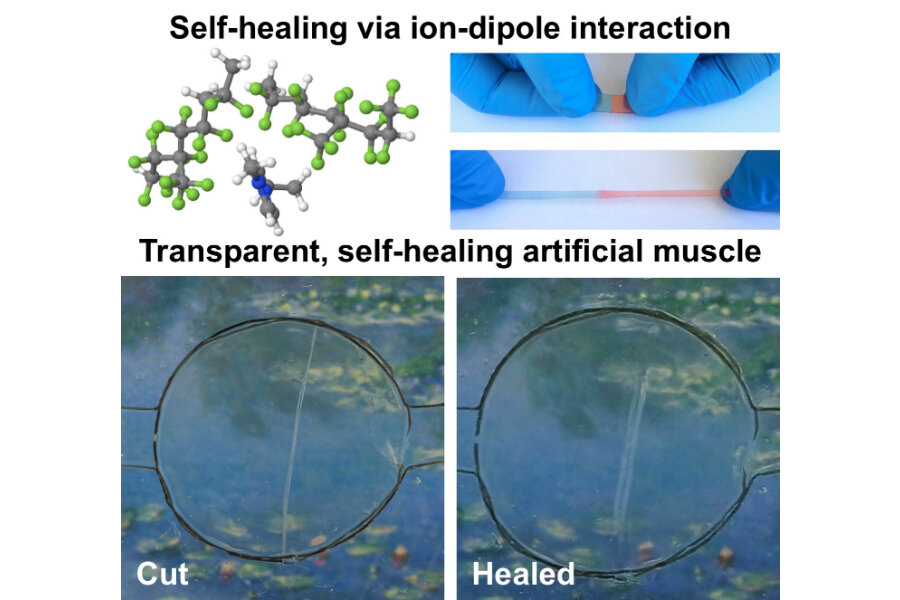Scientists develop 'Wolverine'-inspired material that heals itself
Loading...
It’s not quite Adamantium of Marvel Comics fame, but it’s a start.
In a study published December in the journal Advanced Material, an international team of scientists described the first synthetic ionic conductor – a transparent, self-healing, highly stretchable material that allows ions to flow through it.
The material, which was inspired in part by the regenerative ability of the comic book antihero Wolverine, could someday be used to improve the lifespan of electronic devices or develop self-repairing robots.
“Creating a material with all these properties has been a puzzle for years,” author Chao Wang, a material chemist at the University of California Riverside, said in a statement. “We did that and now are just beginning to explore the applications.”
Most self-healing polymers are held together by noncovalent bonds, which are unstable under certain electrochemical conditions. In an effort to improve material stability, Dr. Wang and colleagues made use of a phenomena called ion-dipole interactions. By combining a polar polymer with highly ionized salt, they were able to produce a stable material that can stretch and repair itself.
When activated by an electrical stimulus, the resulting material is rubber-like and malleable – it can be stretched to 50 times its original length without breaking. When cut with scissors, the material takes just 24 hours to heal, or re-attach to itself, at room temperature. In subsequent trials, researchers demonstrated that it could even power an artificial muscle.
Researchers say their ionic conductor could be used in a wide range of technologies, from biosensors to self-repairing robots.
“Think about a robot,” co-author Christoph Keplinger, a mechanical engineer at the University of Colorado, tells The Christian Science Monitor in an email. “What you usually imagine is a metallic, clumsy piece of hardware that you would not want to have near yourself for any sort of collaboration or interaction – the mismatch in mechanics with the robot being hard and the human body being soft makes direct contact dangerous."
"Now imagine a new class of robots that are based on soft, elastic materials, being powered by stretchable electronic circuits and thus much more closely resemble the elegant design of biology," Dr. Keplinger adds. "This is the type of robot that will soon help us out in the household or help us care for elderly people."
The material could even extend the lifetime of lithium ion batteries, many of which only last a few years. Longer-lasting batteries could be used in plug-in electric cars, thereby lowering manufacturing costs – that’s good news, since the industry is poised to go mainstream as early as this year. As the Monitor reported in November:
Proponents have long argued that sales will increase when cheaper electric cars enter the market. The 2017 Chevrolet Bolt EV will hit dealers next summer. Tesla, Nissan, and Hyundai may debut “affordable” offerings by 2020.
Self-healing materials, once relegated to sci-fi movies and comic books, have emerged as a viable scientific focus in recent years. In 2013, Stanford researchers developed a “synthetic polymer goo” that repairs cracks in silicon electrodes. Silicon electrodes are capable of storing 10 times more power than lithium ion batteries, but they tend to break down as they charge.
The Monitor previously reported:
The hydrogen-bond formation within the polymer works like a zipper to zip up the cracks, explains [lead author Yi] Cui. To keep the mixture electrically conductive, the team also added carbon nanoparticles.
The nanoparticles are so small that there is no risk of them breaking down any further, Cui says. The trick here was keeping up an electrical connection between the tiny particles using a hydrogel.
In 2015, researchers at Delft University of Technology in the Netherlands used a strain of bacteria to develop concrete that repairs itself. Once perfected, the substance could help prevent the inevitable crumbling of public roads and reduce the large carbon footprint of concrete production.
In August, scientists at Pennsylvania State University used a similar approach to create self-mending clothing. By dipping torn fabrics into a special polyelectrolyte coating created from yeast and bacteria, researchers found that pre-woven textiles could essentially sew themselves back up.








